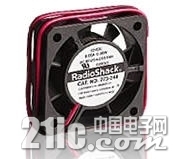|
The unit is amazingly sensitive. It easily sees the dust kicked up from walking on a rug or the vapors from cooking. Looking at the graphs below you can see some interesting things. First you can see that things settle down at night when people are not walking around. You can see around noon that my daughter cooked lunch. It's surprising how long it takes for the fine particles to settle down.
ApproachSet UpAn Arduino Ethernet is connected to the Sharp sensor following the schematic in the Sharp GP2Y1010AU0F Spec sheet. The LED connected to pin 2 is turned on, after 0.28ms the analog pin A0 connected to Vo is sampled. 0.04ms later, the LED is turned off and 9.680ms is waited before the 10ms sequence is repeated (Arduino Source Code).Sharp pin 1 (V-LED) => 5V (connected to 150ohm resister)Sharp pin 2 (LED-GND) => Arduino GND pinSharp pin 3 (LED) => Arduino pin 2Sharp pin 4 (S-GND) => Arduino GND pinSharp pin 5 (Vo) => Arduino A0 pinSharp pin 6 (Vcc) => 5V


I used a small 40mm fan to help make sure air was circulated thru the Sharp sensor. This probably is not required, but since I am mounting one of the sensors outside in a radiation shield, I wanted to make sure I saw any pollen floating by. Testing and Calibration
 The Pancake test :-)
The Pancake test :-)When you read the Sharp GP2Y1010AU0F Spec sheet Fig. 3 shows a Dust density (mg/m^3) versus voltage graph. But the graph starts at over 0.5 VDC. Unfortunately for most of my tests, the voltage was much lower. I entered the values off the graph and calculated a linear equation to approximate the mg/m^3 values. With the inexpensive Sharp sensor, I wanted to see how sensitive it was and I wanted to try to correlate the voltage to some meaningful metric. I tried a quick match test (blew out a match and let the smoke go over the sensor). The smoke quickly saturated the sensor. I wanted a longer term test. After seeing that the dylos sensor could see my daughter cooking lunch, I decided to do a "pan cake" test. Did you ever notice that after making pancakes in an old cast iron fry pan with butter, that the kitchen hazes up. I set up both the Dylos and Sharp sensors to capture the data to Pachube. This allowed me to compare/calibrate the sensors. The two graphs are amazingly similar. Applying a simple offset and multiplication factor allowed the data to be overlaid. (V-0.0356)*120000The interesting thing is that Dylos has a chart to rate your air relative to other residential environments. The pancake test exceed these by 50X. So there is some question of how sensitive the Sharp unit is at very low particle counts. Air Quality Chart - Small Count Reading (0.5 micron)+3000 + = VERY POOR1050-3000 = POOR300-1050 = FAIR150-300 = GOOD75-150 = VERY GOOD0-75 = EXCELLENT
|